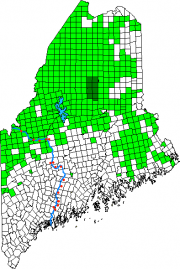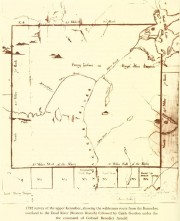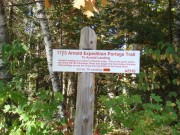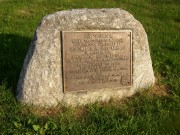click to enlarge
Arnold led an expedition in 1775 from Massachusetts, up the Kennebec River and through the Maine woods to join General Philip Schuyler in an attempt to defeat the British at Quebec. It left Cambridge on September 11th under orders from General George Washington. Follow the expedition with the expanded version of the map at left.
The 1100 man army arrived at Swan Island in Perkins Township near Richmond on September 21st and reached Dresden the following day, stopped at Pittston and arrived at Fort Western in Augusta on the 24th.
After passing through the falls on the Kennebec in Winslow, Skowhegan, and Madison-Anson, the expedition remained at Norridgewock Falls for a week, due to bad weather, until October 9th.
Two days later they reached the Great Carrying Place which provided a link using a portage, from the Kennebec to Dead River via the Carry Ponds. A “formidable number” of the soldiers got sick, and many died, at the Carry. Difficult terrain, rough waters, more illness, a hurricane October 19-21, and then desertions weakened the force as they pushed into the wilderness. The Fourth Division, composed of 400 men, decided to retreat back down the river.
On short rations, the main force finally crossed into Canada at the current international boundary on October 25th and traveled down the Chaudiere River. The party reached Point Levis, opposite Quebec, on November 9th. By November 14th, Arnold had reached and crossed the St. Lawrence River with about 500 men remaining from his original contingent. Veteran Caleb Gordon mentions the trek in his pension deposition.
On December 31st the battle for Quebec began and quickly became a disaster for the Americans. It was especially trying for one veteran of that event, Caleb Gordon. Though keeping the city in a state of siege during that winter, the Canadian campaigned failed but Arnold’s difficult march remains a major achievement. Along the Kennebec, markers are still displayed noting the expedition’s progress.
In 1780 Arnold was exposed for passing secrets to the British, intending to turn over his own command to them. His treason and treachery insured that the name Benedict Arnold would be synonymous with traitor over two hundred years later.
To follow Benedict Arnold’s Expedition Route – click the Bateau
Additional resources
Calvert, Mary R. Dawn over the Kennebec. Lewiston, ME: Twin City Printery, 1983.
Arnold Expedition Historical Society, Headquarters, Major Reuben Colburn House, Arnold Road, Pittston, Maine; Mail: RR 4, Box 6895, Gardiner, ME 04345-9112; Phone: (207) 582-7080.
Desjardin, Thomas A. Through A Howling Wilderness: Benedict Arnold’s March to Quebec, 1775. New York. St. Martin’s Press. 2006.
Hines, Ezra D., 1847-1920. Arnold’s March From Cambridge To Québec [Microform] Salem, Mass. Salem Press. 1898. Orono, Me. University of Maine, Raymond H. Fogler Library






